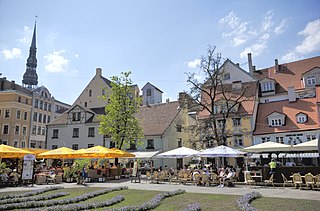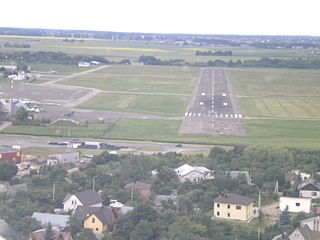
Riga is the capital and largest city of Latvia. Home to 605,802 inhabitants, the city accounts for a third of Latvia's total population. The population of Riga metropolitan area, which stretches beyond the city limits, is estimated at 860,142. The city lies on the Gulf of Riga at the mouth of the Daugava river where it meets the Baltic Sea. Riga's territory covers 307.17 km2 (118.60 sq mi) and lies 1–10 m (3.3–32.8 ft) above sea level, on a flat and sandy plain.

ATA Airlines, Inc. – formerly known as American Trans Air and commonly referred to as ATA – was an American low-cost scheduled service and charter airline based in Indianapolis, Indiana. ATA operated scheduled passenger flights throughout the U.S. mainland and Hawaii, Puerto Rico, and Portugal as well as military and commercial charter flights around the world. In its early days, the airline flew charters on a worldwide basis and had bases in Chicago, Detroit, New York, Indianapolis, Oakland, and Milwaukee. Later, when it entered scheduled service, the airline maintained focus cities at Chicago Midway International Airport, Honolulu International Airport, and Oakland International Airport.

Junkers Flugzeug- und Motorenwerke AG more commonly Junkers, was a major German aircraft and aircraft engine manufacturer. It was founded in Dessau, Germany, in 1895 by Hugo Junkers, initially manufacturing boilers and radiators. During World War I and following the war, the company became famous for its pioneering all-metal aircraft. During World War II the company produced the German army's Luftwaffe planes, as well as piston and jet aircraft engines, albeit in the absence of its founder, who had been removed by the Nazis in 1934.

Hugo Junkers was a German aircraft engineer and aircraft designer who pioneered the design of all-metal airplanes and flying wings. His company, Junkers Flugzeug- und Motorenwerke AG, was one of the mainstays of the German aircraft industry in the years between World War I and World War II. His multi-engined, all-metal passenger- and freight planes helped establish airlines in Germany and around the world.

The Junkers F 13 was the world's first all-metal transport aircraft, developed in Germany at the end of World War I. It was an advanced cantilever-wing monoplane, with enclosed accommodation for four passengers. 322 planes of the type were manufactured, an exceptionally large number for a commercial airliner of the era, and were operated all over the globe. It was in production for thirteen years and in commercial service for more than thirty.

Deutsche Luft Hansa A.G. was a German airline. It served as flag carrier of the country during the later years of the Weimar Republic and throughout Nazi Germany, when it had close links to the Nazi Party.
A/S Latvijas Gāze is a Latvian natural gas company, which deals in the importation and sale of natural gas.

S. Darius and S. Girėnas Airport, also known as Aleksotas Airport, is a small airport located in Aleksotas district of Kaunas City (Lithuania), about 3 kilometres South-west from city centre. On May 6, 1993, the airport was named after the Lithuanian pilots Steponas Darius and Stasys Girėnas, who perished in a crash near the end of an attempted non-stop flight from New York to Lithuania in 1933.

Spilve Airport is a former civilian and military airport in Latvia located 5 km north of Riga's city centre, from which aircraft took off as early as the First World War. It became the first international airport of Riga in the 1920s and fell into disuse in the 1980s after Riga International Airport was built.

Jēkabpils, also known as Krustpils, is an air base located 3 kilometres (2 mi) northeast of Jēkabpils, a town in Latvia. During the 1980s it was one of 17 airfields hosting the Soviet Union's tactical reconnaissance aircraft regiments.

The Junkers G 24 was a German three-engine, all-metal low-wing monoplane passenger aircraft manufactured by Junkers from 1925. Junkers F 24 was the designation for single-engine versions of the same aircraft.

Deruluft was a joint German-Soviet airline, established on 11 November 1921. Deruluft opened its first permanent airlink between Moscow and Königsberg on 1 May 1922. It started a new route between Berlin and Leningrad on 6 June 1928, and maintained both routes until 31 March 1936. Deruluft was a successful business, but terminated on 31 March 1937 due to the changed political situation.

The Fokker F.III was a single-engined high-winged monoplane aircraft produced in the 1920s by the Dutch aircraft manufacturer Fokker. It could carry five passengers. The aircraft was also built under licence in Germany as the Fokker-Grulich F.III.

The Junkers G 31 was an advanced tri-motor airliner produced in small numbers in Germany in the 1920s. Like other Junkers types, it was an all-metal, low-wing cantilever monoplane. In the mid-1920s, the all-metal construction and an aerodynamically 'clean' configuration were remarkable.

Ad Astra Aero was a Swiss airline based at Zürichhorn in Zürich.

Poznań Airline Society Aerotarg was the first Polish airline. It was founded in Poznań on 10 May 1921 mainly in order to serve participants and visitors of the first Poznań International Fair. Aerotarg operated the first regular air connection in Poland - the Poznań-Warsaw route, as well as the international connection between Poznań and the Free City of Danzig (Gdańsk).

Aeronaut was an Estonian airline which existed between 1921 and 1928. It was the first Estonian airline.
Lithuanian Air Lines was a national state-owned airline of Lithuania, operating in 1938–1940. Its hub was in Kaunas Aleksotas airport.

Valsts gaisa satiksme was a state-owned national airline of Latvia, which operated between 1937 and 1940. Its hub was Spilve airport, in Riga, Latvia.

















